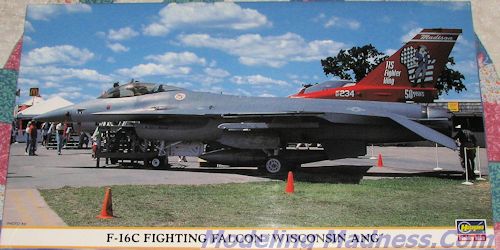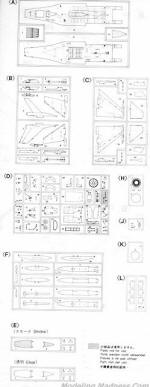
Hasegawa 1/48 F-16C 'Wisconsin ANG'
| KIT #: | 09378 |
| PRICE: | 2400 yen when new |
| DECALS: | One option |
| REVIEWER: | Scott Van Aken |
| NOTES: | 2001 Limited Edition |

| HISTORY |
F-16C (single seat) and F-16D (two seat) variants were introduced in service in 1984. The Block 25 was the first C/D block. It added all-weather capability with beyond-visual-range (BVR) AIM-7 and AIM-120 air-air missiles. Block 25 introduced a substantial improvement in cockpit avionics, and improved AN/APG-68 radar. Block 25s were first delivered with the Pratt & Whitney F100-PW-200 engine and later upgraded to the Pratt & Whitney F100-PW-220E. A total of 209 Block 25 aircraft were delivered. The F-16C/D had a unit cost of US$18.8 million (1998).
Block 30/32 was the first block of F-16s affected by the Alternative Fighter Engine project under which aircraft were fitted with the traditional Pratt & Whitney engines or, for the first time, the General Electric F110-GE-100. From this point on, blocks ending in "0" (e.g., Block 30) are powered by GE, and blocks ending in "2" (e.g., Block 32) are fitted with Pratt & Whitney engines. The first Block 30 F-16 entered service in 1987. Major differences include the carriage of the AGM-45 Shrike, AGM-88 HARM, and the AIM-120 missiles. From Block 30D, aircraft were fitted with larger engine air intakes (called a Modular Common Inlet Duct) for the increased-thrust GE engine. A total of 733 Block 30/32 aircraft were produced and delivered to six countries.
The USAF has pretty well started thinning down its F-16C fleet with the Block 25 planes being relegated to the bone yard as well as a goodly number of the later Block 30/32 versions. This is due as much to budget issues (like paying for the super-expensive F-35) as much as the age of the aircraft.
| THE KIT |
 Hasegawa's F-16 kit has been around for an age and when they developed the F-16C, rather than changing the panel lines and such on their F-16A kit, they simply added the appropriate F-16C bits. This, of course, threw some modelers into a pique of rage at how Hasegawa could possibly foist such a Frankenstein's monster on poor, unsuspecting modelers. Most of us have survived with minimal trauma.
Hasegawa's F-16 kit has been around for an age and when they developed the F-16C, rather than changing the panel lines and such on their F-16A kit, they simply added the appropriate F-16C bits. This, of course, threw some modelers into a pique of rage at how Hasegawa could possibly foist such a Frankenstein's monster on poor, unsuspecting modelers. Most of us have survived with minimal trauma.
This boxing was released in 2001 so the molding is still quite nicely done. There are the usual small ejector pin marks on missiles, gear legs, wheels and so on, but that is pretty standard stuff with kits of this generation. The engraved detailing is quite nice and most will find it to be pleasing. Despite the wings having upper and lower halves, Hasegawa has decided that we need all the pylon holes opened for us. While on the wings, these do not have the 'beercan' antennas that were retrofitted to US F-16Cs.
The cockpit is nicely done and comes with a pilot figure to cover up the somewhat generic Aces bang seat. Decals are provided for none of the instrument panels, the modeler needing to paint the nicely done raised detail on these items. During constructions, a few holes will need to be opened and some bits cut to match the proper variant or to have some features in their optional position. This is especially true of the speed brakes, which one almost never sees open on the ground.
One of the more complex constructs is building the afterburner petals up into a circle. I seem to recall this being a tad fiddly when I last built a Hasegawa F-16C many, many years back. One of the other options is having the cockpit canopy open or closed. Hasegawa provides both clear and lightly tinted clear bits. Both have a seam running down the middle that will have to be sanded away. Modern jets need to have things under the wings so this one provides a centerline tank, two huge wing tanks, a bomb pylon, and a missile pylon. For weapons, you get two Sidewinders and two AIM-120. A travel pod is also provided.
huge wing tanks, a bomb pylon, and a missile pylon. For weapons, you get two Sidewinders and two AIM-120. A travel pod is also provided.
| CONCLUSIONS |
I would probably be correct to say that this kit has been built by the tens of thousands over the years and Hasegawa is still using the basic bits to do other boxings. I know the last standard F-16C boxing I reviewed several years back retailed for $45, something that definitely deters some modelers from going the Hasegawa route for their F-16. However, for those who like F-16s, it can easily be found for a most reasonable price from various vendors at hobby shows.
| REFERENCES |
Wikipedia is my usual choice
August 2014 Thanks to me for the preview kit. If you would like your product reviewed fairly and fairly quickly, please contactthe editor or see other details in the